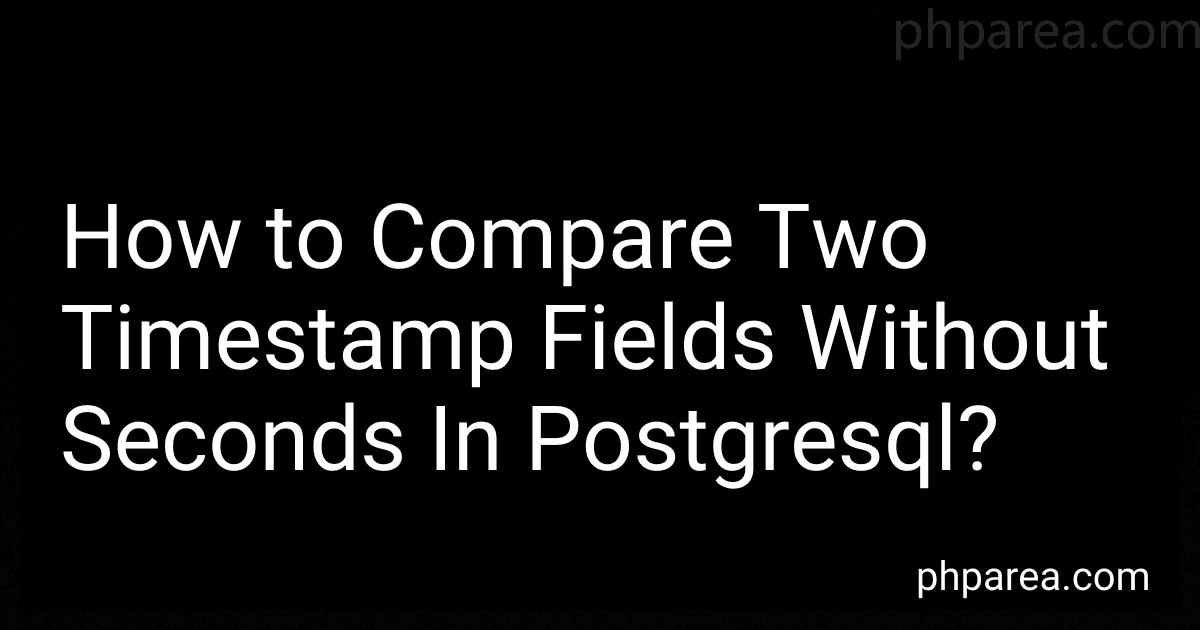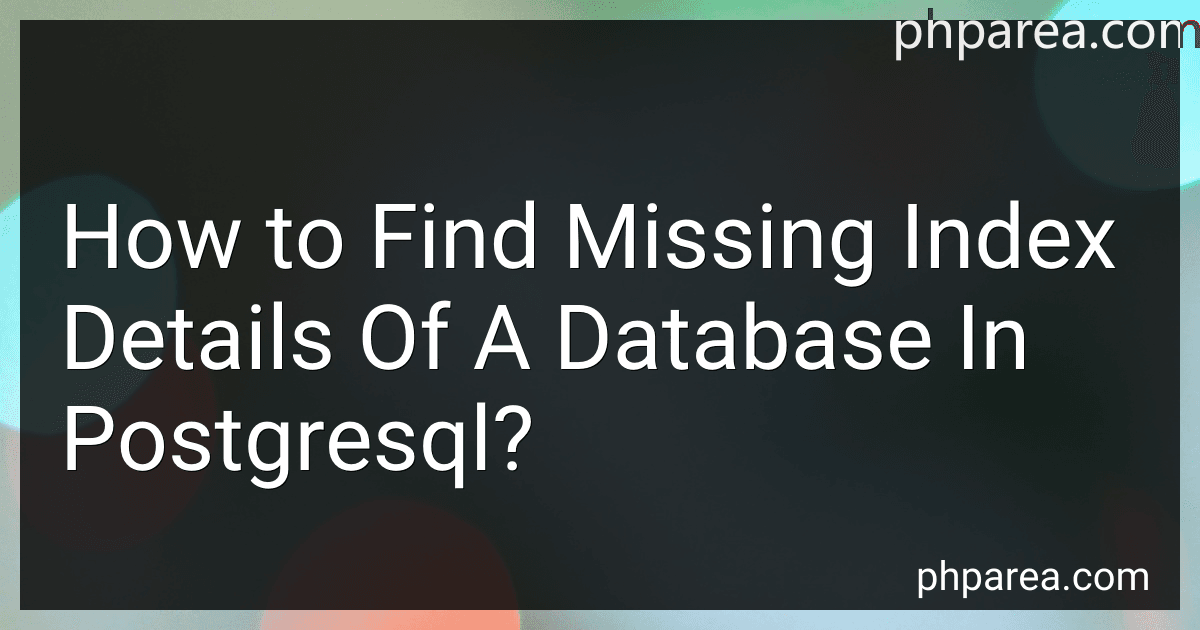PHP Blog
-
 4 min readTo compare two timestamp fields without considering the seconds in PostgreSQL, you can use the date_trunc function to truncate the timestamps to the nearest minute or hour. By truncating the timestamps, you can compare them based on their hour and minute values without taking the seconds into account. This allows you to easily determine if the two timestamps represent the same time without worrying about the exact second.
4 min readTo compare two timestamp fields without considering the seconds in PostgreSQL, you can use the date_trunc function to truncate the timestamps to the nearest minute or hour. By truncating the timestamps, you can compare them based on their hour and minute values without taking the seconds into account. This allows you to easily determine if the two timestamps represent the same time without worrying about the exact second.
-
 5 min readIn PostgreSQL, you can raise a specific exception using the RAISE statement. This statement allows you to raise a custom exception, along with a custom message and error code.
5 min readIn PostgreSQL, you can raise a specific exception using the RAISE statement. This statement allows you to raise a custom exception, along with a custom message and error code.
-
 5 min readTo create a folder to save output in PostgreSQL, you can use the command \o followed by the desired file path to redirect the output to a file. For example, you can type \o /path/to/folder/output.txt to save the output of your queries to a file called output.txt in the specified folder. This will allow you to save and store the query results in a specific location on your system for future reference or analysis.
5 min readTo create a folder to save output in PostgreSQL, you can use the command \o followed by the desired file path to redirect the output to a file. For example, you can type \o /path/to/folder/output.txt to save the output of your queries to a file called output.txt in the specified folder. This will allow you to save and store the query results in a specific location on your system for future reference or analysis.
-
 9 min readHibernate is an object-relational mapping framework that allows Java developers to use objects to interact with a database. When mapping Hibernate to a PostgreSQL table, Hibernate uses annotations to define the mapping between Java classes and database tables.Hibernate translates Java objects to SQL queries that interact with the database, allowing developers to work with objects in their code without directly manipulating SQL.
9 min readHibernate is an object-relational mapping framework that allows Java developers to use objects to interact with a database. When mapping Hibernate to a PostgreSQL table, Hibernate uses annotations to define the mapping between Java classes and database tables.Hibernate translates Java objects to SQL queries that interact with the database, allowing developers to work with objects in their code without directly manipulating SQL.
-
 2 min readIn PostgreSQL, you can use the COUNT() function to get the count of a specific column value. You can specify the column name inside the COUNT() function to get the count of non-null values in that column.
2 min readIn PostgreSQL, you can use the COUNT() function to get the count of a specific column value. You can specify the column name inside the COUNT() function to get the count of non-null values in that column.
-
 4 min readTo view data from a specific column in PostgreSQL, you can use the SELECT statement along with the column name you want to retrieve data from. For example, if you have a table named "customers" with columns "id", "name", and "email", and you want to view data from the "name" column, you can use the query:SELECT name FROM customers;This will fetch data from the "name" column of the "customers" table in PostgreSQL.
4 min readTo view data from a specific column in PostgreSQL, you can use the SELECT statement along with the column name you want to retrieve data from. For example, if you have a table named "customers" with columns "id", "name", and "email", and you want to view data from the "name" column, you can use the query:SELECT name FROM customers;This will fetch data from the "name" column of the "customers" table in PostgreSQL.
-
 4 min readTo capture changes in PostgreSQL, you can use various methods such as using triggers, logical decoding, or database replication. Triggers are database objects that are automatically executed when certain events occur, such as when a row is inserted, updated, or deleted. By creating triggers on tables of interest, you can capture changes and take appropriate actions.
4 min readTo capture changes in PostgreSQL, you can use various methods such as using triggers, logical decoding, or database replication. Triggers are database objects that are automatically executed when certain events occur, such as when a row is inserted, updated, or deleted. By creating triggers on tables of interest, you can capture changes and take appropriate actions.
-
 6 min readTo find missing index details of a database in PostgreSQL, you can use the built-in query planner called EXPLAIN. This tool can provide information on how queries are being executed, including whether indexes are being used effectively. By running queries with EXPLAIN, you can analyze the query plan and identify any missing indexes that could improve performance. Additionally, you can use the pg_stat_user_indexes system view to check for missing indexes on specific tables in your database.
6 min readTo find missing index details of a database in PostgreSQL, you can use the built-in query planner called EXPLAIN. This tool can provide information on how queries are being executed, including whether indexes are being used effectively. By running queries with EXPLAIN, you can analyze the query plan and identify any missing indexes that could improve performance. Additionally, you can use the pg_stat_user_indexes system view to check for missing indexes on specific tables in your database.
-
 3 min readIn PostgreSQL, you can structure nested arrays by using multidimensional arrays or JSONB data type.One approach is to use multidimensional arrays, where you can have arrays within arrays to represent nested data structures. For example, you can create a multidimensional array by defining an array within another array like this: {{1,2,3},{4,5,6}}.Another approach is to use the JSONB data type, which allows you to store nested arrays as JSON objects.
3 min readIn PostgreSQL, you can structure nested arrays by using multidimensional arrays or JSONB data type.One approach is to use multidimensional arrays, where you can have arrays within arrays to represent nested data structures. For example, you can create a multidimensional array by defining an array within another array like this: {{1,2,3},{4,5,6}}.Another approach is to use the JSONB data type, which allows you to store nested arrays as JSON objects.
-
 4 min readTablespaces in PostgreSQL are a way to logically group and manage database objects. They are useful for organizing data, optimizing performance, and controlling access to certain parts of the database.To manage tablespaces in PostgreSQL, you can create, modify, and drop tablespaces using SQL commands like CREATE TABLESPACE, ALTER TABLESPACE, and DROP TABLESPACE. You can also move data between tablespaces using the ALTER TABLE command with the SET TABLESPACE option.
4 min readTablespaces in PostgreSQL are a way to logically group and manage database objects. They are useful for organizing data, optimizing performance, and controlling access to certain parts of the database.To manage tablespaces in PostgreSQL, you can create, modify, and drop tablespaces using SQL commands like CREATE TABLESPACE, ALTER TABLESPACE, and DROP TABLESPACE. You can also move data between tablespaces using the ALTER TABLE command with the SET TABLESPACE option.
-
 6 min readConnection pooling in PostgreSQL helps optimize the usage of database connections and improve performance by reducing the overhead of establishing new connections for every request. To configure connection pooling in PostgreSQL, you can use tools like pgBouncer or pgbadger. These tools allow you to set up a pool of database connections that can be reused by multiple client applications, reducing the number of connections established and closed frequently.
6 min readConnection pooling in PostgreSQL helps optimize the usage of database connections and improve performance by reducing the overhead of establishing new connections for every request. To configure connection pooling in PostgreSQL, you can use tools like pgBouncer or pgbadger. These tools allow you to set up a pool of database connections that can be reused by multiple client applications, reducing the number of connections established and closed frequently.